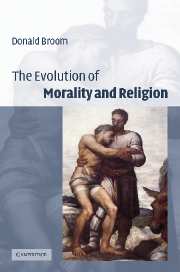Book contents
- Frontmatter
- Contents
- Preface
- Acknowledgements
- 1 Concepts and codes of living
- 2 Cooperation, altruism, reciprocal altruism
- 3 Biological capabilities needed for altruism and morality
- 4 Ideas about morality
- 5 The origins and value of religion
- 6 Other views about the origins of morality and religion
- 7 Social and political consequences of this biological view of morality and religion
- 8 Conclusions
- References
- Species list
- Author index
- Subject index
2 - Cooperation, altruism, reciprocal altruism
Published online by Cambridge University Press: 18 December 2009
- Frontmatter
- Contents
- Preface
- Acknowledgements
- 1 Concepts and codes of living
- 2 Cooperation, altruism, reciprocal altruism
- 3 Biological capabilities needed for altruism and morality
- 4 Ideas about morality
- 5 The origins and value of religion
- 6 Other views about the origins of morality and religion
- 7 Social and political consequences of this biological view of morality and religion
- 8 Conclusions
- References
- Species list
- Author index
- Subject index
Summary
THE COMMONALITY OF GENES AND THE CONCEPTS OF ALTRUISM
The system controlling any behaviour develops in the individual as a consequence of interactions between the genotype and its environment. Hence it is of value to consider how genes might influence behaviour and to consider how a gene which does so might have spread in the population. Those who have sought to explain altruistic behaviour towards close relatives have found it useful to consider degrees of relatedness because these would allow estimation of the likelihood that a gene which promoted altruistic behaviour would be shared with the individual who benefitted from the act. Hamilton (1963, 1964a, b) referred to degrees of relatedness such as 0.5 between parents and offspring and between siblings and 0.25 between grandparents and grandchildren. However, other authors sometimes made the assumption that degree of relatedness could be translated directly to the number of genes in common. Alexander (1979, p. 45) said ‘full siblings on average have 50% of their genes in common’ and Barash (1979, p. 134) referring to bees with haploid reproductive males said ‘each worker shared three quarters of its genes with its sisters’. However, as Broom (1981, p. 10) explained:
it is not correct to say that the siblings share 50% of their genes because this depends upon the variability within the species. Many genes are the same for all individuals because they code for some essential protein which will not function if its structure is altered … the actual proportion of genes shared by siblings is much higher than 50%
- Type
- Chapter
- Information
- The Evolution of Morality and Religion , pp. 30 - 83Publisher: Cambridge University PressPrint publication year: 2003
- 1
- Cited by



